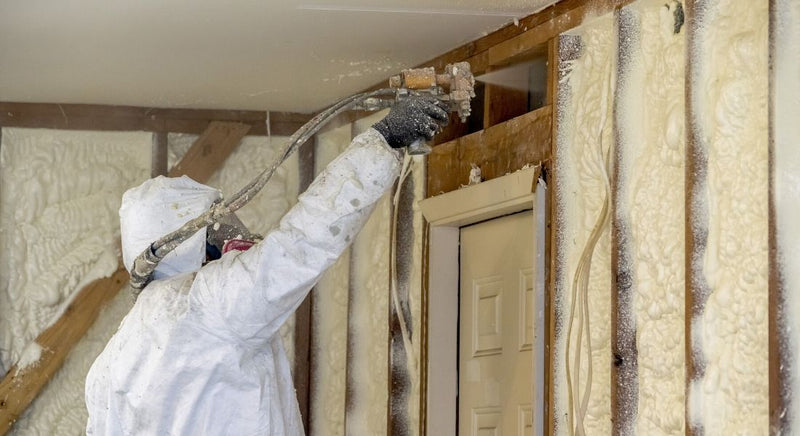Contrasting Spray Foam to Traditional Insulation: Which Is Better?
Exactly How Spray Foam Can Enhance Energy Efficiency in Any Kind Of Structure
Spray foam insulation has emerged as a pivotal solution for enhancing power efficiency throughout different building kinds. As property owners progressively look for lasting options, the implications of spray foam insulation extend beyond mere utility financial savings.
Understanding Spray Foam Insulation
Spray foam insulation is progressively acknowledged for its remarkable thermal performance and versatility in different applications. Made up mainly of polyurethane, this insulation product is used as a fluid that broadens upon call, filling up gaps and producing a seamless barrier. This unique property permits spray foam to adapt irregular surfaces, making it an optimal choice for both industrial and property structures.

Application of spray foam insulation is normally performed by qualified experts making use of specific tools, guaranteeing ideal efficiency and safety and security - Spray Foam. The curing procedure is fast, permitting fast installment and minimal interruption. As a result, spray foam insulation is progressively being utilized in brand-new building and retrofitting jobs because of its ability to boost architectural honesty while improving general power efficiency in buildings
Benefits of Power Efficiency
Energy efficiency plays an essential role in minimizing functional prices and reducing ecological effect throughout different industries. By optimizing power use, home owners and companies can attain significant cost savings on utility costs, which directly boosts monetary efficiency. Effective energy usage suggests less reliance on nonrenewable fuel sources, therefore adding to a reduction in greenhouse gas exhausts and promoting a more sustainable setting.
Moreover, energy-efficient buildings commonly experience increased property values. As energy costs climb and sustainability ends up being a concern for customers, residential properties with enhanced energy performance functions are a lot more appealing on the marketplace. This trend motivates investment in energy-saving innovations, which can better drive development and economic development.
Along with environmental and monetary advantages, energy performance can additionally boost the overall comfort and wellness of indoor spaces. Correct insulation and reliable cooling and heating systems aid keep regular temperature levels, decreasing drafts and humidity degrees, which in turn can lead to far better indoor air quality.
Eventually, the advantages of energy efficiency extend past instant cost savings, fostering a durable economic situation, advertising environmental stewardship, and enhancing the quality of life for owners in any kind of structure.
Just How Spray Foam Works
Typically applied as a fluid, spray foam broadens swiftly upon contact with surface areas, developing a strong obstacle that successfully seals splits and spaces. This unique building is due to its chemical make-up, mainly being composed of polyols and isocyanates, which respond when mixed to produce a foam that loads voids and sticks to different materials, consisting of concrete, wood, and steel.
When applied, the foam expands to several times its original volume, making sure a limited seal that protects against air leakage. This process considerably minimizes thermal linking, which takes place when warmth transfers with products, bring about energy loss. The foam's high R-value, a procedure of thermal resistance, adds to improved insulation by lessening warmth transfer in between the interior and exterior atmospheres.
In addition, spray foam is resistant to moisture and insects, additionally improving its efficacy in keeping power performance. Its application can be tailored to different areas, including attics, walls, and crawl areas, enhancing insulation throughout a building. Spray Foam. On the whole, the innovative style and application approach of spray foam make it a reliable remedy for boosting energy efficiency in any framework, resulting in reduced energy costs and a more lasting constructed setting

Applications in Different Buildings
Many applications of spray foam insulation can be found throughout different structure kinds, enhancing power efficiency and convenience. In residential homes, spray foam is commonly utilized in wall surfaces and attics to produce a smooth barrier against air leakages, dramatically reducing home heating and cooling demands. This application is particularly beneficial in older homes, where standard insulation might be inadequate.
In business structures, spray foam insulation is put on roof covering systems and exterior wall surfaces, which assists to boost thermal efficiency and protect against moisture invasion. Its lightweight nature makes it an excellent selection for retrofitting existing structures without including significant weight. Additionally, spray foam can be used in industrial settings to shield pipes and storage tanks, maintaining temperature control for sensitive materials.
Institutional structures, such as schools and health centers, take advantage of spray foam insulation by ensuring a constant indoor climate that supports occupant comfort and health and wellness. The adaptability of spray foam permits it to adjust to numerous structure shapes and sizes, making it a favored option for architects and builders seeking reliable moved here insulation services. In general, spray foam insulation functions as a vital part in accomplishing energy-efficient buildings across all markets.
Long-Term Expense Savings
Spray foam insulation offers substantial long-lasting expense savings for structure owners and occupants by reducing power usage and decreasing energy bills. By supplying a premium air seal, spray foam minimizes the seepage of outdoors air, consequently improving the thermal efficiency of a building. This causes a lot more efficient home heating and cooling processes, which can cause substantial decreases in power prices over time.
Along with prompt cost savings on utility expenses, the sturdiness and longevity of spray foam insulation add to its financial advantages. Unlike traditional insulation materials, which might sag, clear up, or wear away, spray foam preserves its performance for decades, minimizing the requirement for constant substitutes or repair services. This longevity converts to lower maintenance costs and much less disruption for occupants.
Moreover, buildings equipped with spray foam insulation often enjoy a rise in residential or commercial property worth, making them extra enticing to possible purchasers or lessees. As energy efficiency comes to be increasingly prioritized, properties with effective insulation options stand out out there. Inevitably, the integration of spray foam insulation not just boosts comfort but also represents a calculated investment that generates significant monetary benefits over the long-term.
Final Thought
Finally, spray foam insulation acts as an important element in improving energy effectiveness throughout diverse structure types. Its capacity to develop a seamless barrier against air leak, i was reading this integrated with high R-values and moisture-resistant buildings, considerably decreases power usage and connected costs. The application of spray foam not only adds to constant interior temperature levels however additionally click for more info boosts building worth, highlighting its duty as a prudent financial investment for both industrial and residential properties.
Spray foam insulation has actually emerged as an essential remedy for enhancing energy efficiency across different building kinds. Spray Foam. As an outcome, spray foam insulation is significantly being used in new building and construction and retrofitting projects due to its capability to boost architectural honesty while enhancing total energy performance in buildings
Generally, the ingenious layout and application technique of spray foam make it an efficient remedy for improving power effectiveness in any kind of framework, leading to lowered power costs and a more sustainable constructed setting.
Many applications of spray foam insulation can be located throughout different building kinds, improving energy effectiveness and convenience.In final thought, spray foam insulation offers as an important component in improving power performance throughout varied structure kinds.